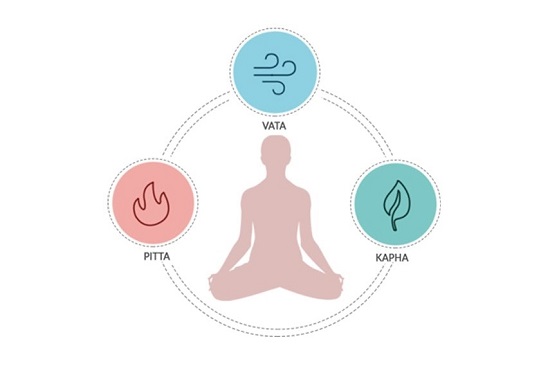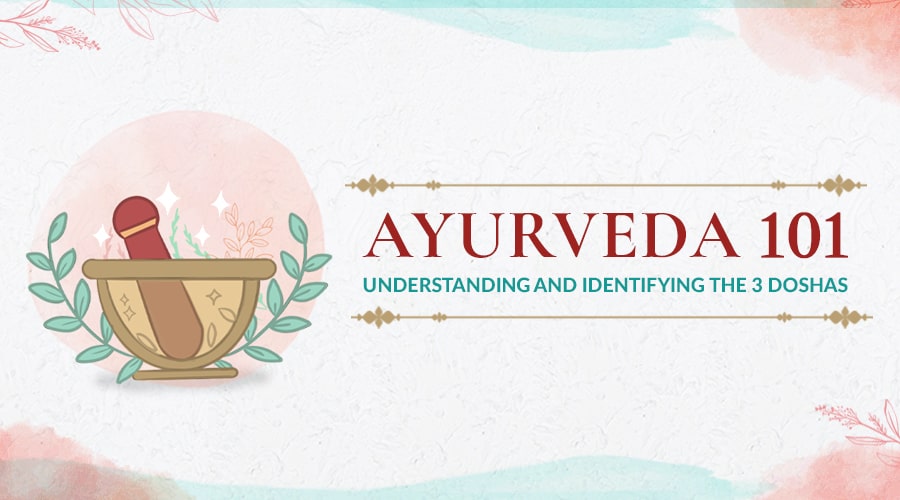Ayurveda is an ancient Indian system of medicine that focuses on creating balance and harmony within the body, mind, and spirit. One of the fundamental concepts of Ayurveda is the doshas; three energy forces that govern the body and mind. These doshas are Vata, Pitta, and Kapha, and they are each associated with different physical and mental characteristics.
In this blog, we will explore the three doshas in Ayurveda and how they can affect our overall health and well-being. We will delve into the unique characteristics of each dosha, including the physical and mental attributes associated with each one. We will also uncover common dosha symptoms people experience when there is an imbalance of elements. By understanding the doshas, we can gain a deeper understanding of our own health and well-being, and take steps to create more harmony in our lives.
What Is Ayurveda?
Ayurveda is an approach to healthcare that developed in India thousands of years ago. The three oldest scriptures are Charka Samhita, Sushruta Samhita, and Ashtanga Hridya. The word Ayurveda is a combination of the Sanskrit words "ayur" (meaning life) and "veda" (meaning science or knowledge). The literal translation is, therefore, the science of life or the science of living a healthy life.
Although Ayurveda has been practiced and taught in India since ancient times, many invading forces threatened to destroy it. Centuries of Muslim occupation introduced different medical practices to India, followed by European invasion. However, thanks to those who continued to practice and teach Ayurveda, we still have much of the ancient knowledge today.
What Are the Fundamental Principles of Ayurveda?
Ayurveda's complete knowledge, science, and practice are based on one foundational concept: the theory of five primal elements. These five elements are the building blocks of the universe and all life, including human bodies.
The five primal elements are:
- Earth
- Water
- Fire
- Air
- Space or ether
Sages in ancient times understood the five elements and their role in the health of our body and mind. So, they developed Ayurveda as a science to balance these elements in our bodies.
The second fundamental principle of Ayurveda, and the aspect that sets it apart from most medical practices, is that Ayurveda's primary purpose is to maintain good health. Ayurvedic medicine does offer treatments for health problems, but treating disease is a secondary function. The primary intention of the Ayurvedic practice has always been to prevent disease or health problems from arising in the first place.
What Is a Dosha in Ayurveda?
Although dosha is commonly used to talk about body type or constitution, it translates more accurately as "fault" or "accumulation."
Our body is made of five elements, and we need to renew these five elements regularly. That is why we drink fresh water and release old water. If we only drink fresh water and never purge our bodies, we will have diseases. Therefore accumulation is called 'fault,' the fault of not refreshing the element.
This means that when you identify your body's dosha, you recognize the elements that usually accumulate in your body. This will be explained in more detail below.
Understanding the Different Dosha Body Types
Our tendency to accumulate different elements results in three doshas. Each dosha is based on a pair of elements with its own distinct functions and properties. The first element is considered the dosha's primary (most influential) aspect. Therefore, the element you most accumulate is the primary element of your dosha.
- Vata – dosha of air and space (ether) elements
- Pitta – dosha of the fire and water elements
- Kapha – dosha of water and earth elements
Your dosha is neither good nor bad. It is simply your characteristics. Understanding your tendency to accumulate an element will help you stay balanced and healthy.
Nature gave people these tendencies for a good reason; your dosha is determined by the environment your ancestors called home. For example, suppose your ancestors are from northern Europe. In that case, you tend to retain the element of fire (heat) to help you survive the cold weather. Likewise, people from hot or dry areas are likely to retain the element of water to help them cope with that environment.
Many people now live in places different from their ancestral homes, so their tendency to accumulate a particular element might become a problem instead of a helpful trait. You can learn to manage your dosha but you can't change it. Your dosha is carried in your genes and would take many generations to adapt to a new environment.
How Do Doshas Become Imbalanced?
There are two important points to understand about doshas:
- Elements are continuously replaced in our bodies. If we don't release the old and replace it with the new, this is a fault that will lead to health problems.
- Balance does not mean all elements are equal. It means all elements are constantly renewed, and there is no build-up of one.
We naturally renew elements in our bodies all the time. We drink water to replace the water we sweat or pass as urine. We breathe in fresh air and breathe out used air. We are constantly in a cycle of bringing new elements into our bodies and ridding ourselves of old elements. If this cycle is disturbed, it creates a fault that leads to disease in the body.
Numerous factors can influence your doshas: environment, diet, seasons, or age. These influences can tip the delicate balance of your dosha and cause one element to increase and another to reduce. Elements also impact your chakras in the same way. For example, suppose your Root Chakra is imbalanced, and you have too much of one element and not enough of another. This imbalance will disrupt the natural flow of the energy system and cause various emotional and physical health problems.
How to Identify Your Dosha Body Type
To keep the elements of your body balanced, you need to understand what your dosha is and the primary element you tend to accumulate. Doshas are not hidden secrets; you must learn how to see them. Let's explore the characteristics of the three dosha body types and common symptoms people experience when there is an imbalance of elements.
1. Vata Dosha

Vata has the primary element of air. Vata energy is responsible for movement in the body and nervous activity. Creatures with Vata dosha are associated with being lightweight and cool with dry skin, similar to a mouse.
Vata Dosha Body Type
A person with Vata dosha has a light and thin bone structure and finds it difficult to gain weight. Their skin and hair tend to be rough and lack moisture. Their skin typically has a brownish tone, and their hair is usually light gray, white, or brown. Vata body types will often feel cold, and because of this, they don't like cool weather.
Vata people may need braces due to uneven teeth structure, as the lightness of their bone structure means their teeth chip easily. They also have dry gums and eyes, resulting in excessive blinking. Their eyes appear small and curious and are light-colored, with the whites having a tint of brown or blue.
People with Vata dosha naturally tend to snack and prefer soft, crackly foods. They eat at random times and multitask with other activities while eating. When the air element accumulates without renewing, Vata people have an irregular appetite which can cause food allergies.
Vata Dosha Symptoms:
When the Vata element accumulates, the likely health symptoms are constant pains that may be in different places each day. Common Vata dosha symptoms include:
- Headaches
- Migraines
- Eye problems
- Anxiety
- Panic attacks
- Constipation
- Dehydration
- Easily distracted
2. Pitta Dosha

Pitta has the primary element of fire. However, the fire element is not literally about flames but more about the heat. An animal example of Pitta dosha is a lion. Pitta is responsible for all the processes involving digestion and our body temperature, vision, intellect, and courage.
Pitta Dosha Body Type
A Pitta person, like a lion, has a moderate bone structure and body weight. Their skin is soft, warm, and oily. Their coloring is fair and bright, with blonde, light brown, or reddish hair. Their hair is soft and silky but tends to go gray early. They have bright and colorful eyes of green, blue, or grey, while the whites of their eyes will have a yellow tint.
Pitta people's teeth are medium in size and well-shaped. Pitta people like to eat regularly, at set times. They eat very fast and prefer colorful, healthy foods. They enjoy large meals and pay little attention to anything else when eating. If they get hungry, they become angry and potentially unreasonable. In addition, they feel thirsty often because of the heat and require large amounts of water. Pitta-type people are also very busy, ambitious, and enjoy high-energy activities.
Pitta Dosha Symptoms
If the Pitta element accumulates, disease tendencies often relate to digestion problems. These include:
3. Kapha Dosha

Kapha has the primary element of water. An animal characteristic of Kapha is the elephant. Kapha energy is essential for union, stability, softness, and strength.
Kapha Dosha Body Type
Like the elephant, a Kapha person will have a large, muscular frame and a heavier body weight. The skin of a Kapha person is thicker, oily, and will feel cool to the touch. Their skin color is pale, but their hair is dark and wavy. They lose hair volume quickly as they age, so they are the most likely to have thinning hair and balding patterns.
Because of their strong frame, Kapha people have strong teeth and gums. They have large, dark eyes with thick eyelashes. The whites of their eyes have a reddish tint, and their gaze tends to be dreamy rather than alert.
Kapha people enjoy their food, can eat anything, and rarely have food allergies. Their natural eating habits include predictable meal sizes and slow, steady eating. Kapha people are also organized, easy-going and precise.
Kapha Dosha Symptoms
When the Kapha element accumulates, health problems develop slowly and can go undetected for a long time. Kapha symptoms can include:
- Dehydration
- Slow bowel movements
- Excess mucus
- Sore throat
- Fatigue
Identifying Your Dominant Dosha
Many people will have easily identified their dosha while reading the descriptions above. However, some people have more than one dosha making it more difficult to figure out which dosha body type you fall into.
If you want more guidance in identifying your dosha, we have created a helpful dosha quiz to help you find your dominant element. Try it for free below.

Discover your Ayurvedic constitution (dosha-dominance) with our free self-assessment.
Fill out our specially curated assessment to discover your dosha balance.
How to Balance Doshas
There are numerous methods to balance the doshas. One of the most common is Shat Kriyas, or six yogic cleansing techniques. It's also important that you follow a holistic diet that complements your dosha makeup. Living a balanced yogic lifestyle with regular exercise, yoga and meditation practice is also key.
Final Thought
Ayurvedic medicine offers treatment for health issues, but its primary aim is to maintain good health and avoid these issues from occurring in the first place.
It's important to remember that balance in Ayurveda refers to a balance of new elements entering and old elements exiting the body. It doesn't mean all elements are equal. However, understanding the fundamentals of Ayurveda will help you create better lifestyle habits and lead a healthier, more balanced life.

